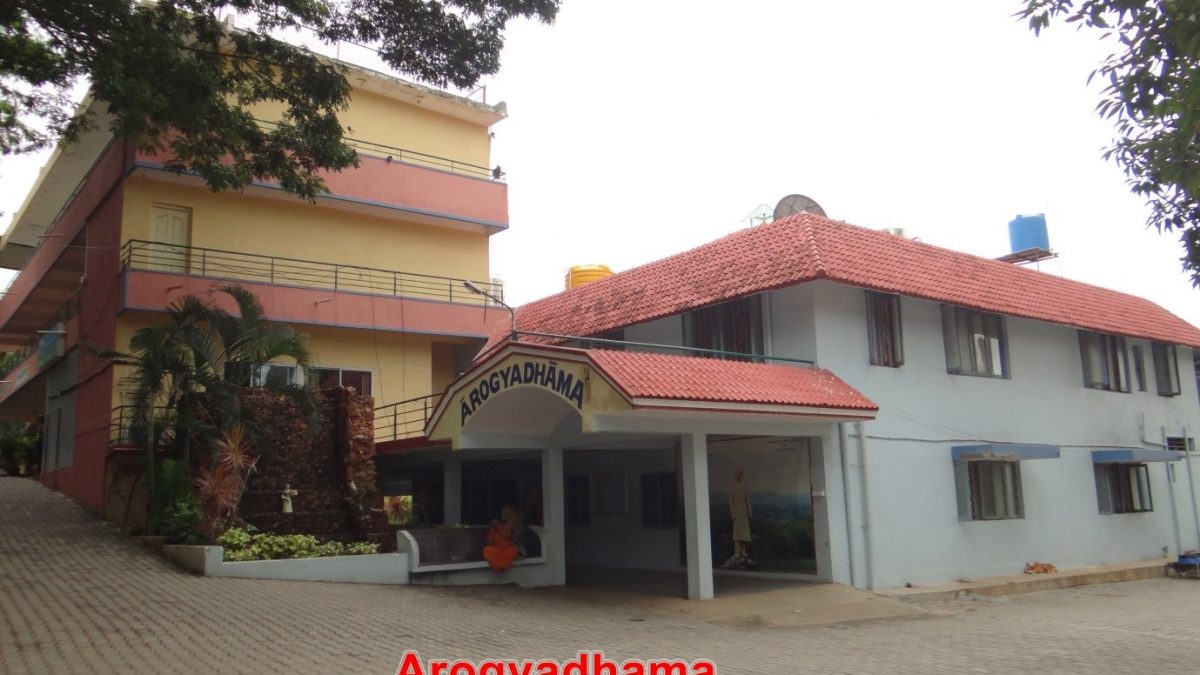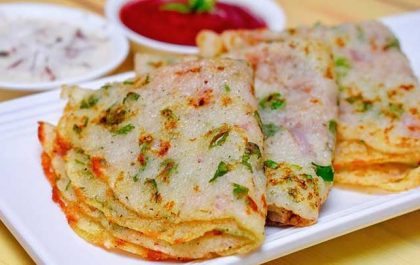Yoga Vidya Niketan (YVN), Member Institute of Indian Yoga Association successfully conducted its annual one-month Yoga Summer Course from May 1 to May 31, 2024. The course ran for one and a half hours daily across 41 physical centers around Mumbai and Navi Mumbai, extending…
Arogyadhama, the residential integrative health home of
S-VYASA, Bengaluru
by Dr. Suchitra Patil, BAMS, MD, PhD
S-VYASA hosts Arogyadhama, a 600 bed inpatient treatment facility. It is an Integrative Holistic Research Health Home that uses self-healing techniques based on research by Swami Vivekananda Yoga Anusandhana Samsthana (S-VYASA). The university is a premier yoga research institution with over 750 research papers published in leading peer reviewed national and international journals on yoga in health, education, management, and other fields. The integrative health home that started in 1986 is located in a serene 110 acre campus and in a lush green valley facing the east and is 35kms south of Bengaluru city.

Need for Integration
The need to start this centre was envisaged by a team of doctors and thinkers who were concerned with the lopsided development of medical practices. Modern medicine has progressed rapidly with intense work on creating evidence-based knowledge; we must thank the whole bunch of researchers and clinicians for it. No doubt we have increased longevity, made old age liveable, reduced infant mortality by the numerous medicines and procedures. But has this reduced the prevalence of diseases and the total quantum of distress related to it? Diseases, and the afflicted are not reducing in numbers; we have not found cures for many of the diseases except remarkable successes with emergency care. Even the infections by mutated germs have posed mega challenges as seen in Covid-19 pandemic.
What is the Reason?
The reason is the knowledge base. We lost sight of the whole individual. Researchers treated the body like a mega machine and were advised to design experiments by considering mind and emotions as non-existing entities while searching for the causation and progress of a disease. We became totally organ oriented with a telescopic view of the mega machine. An eye specialist does not know what is happening to the heart or the kidney and so on, like the example of ten blind men trying to describe an elephant. Do the body parts really function independent of each other? In 1960s, we started realizing the influence of psyche and stress on the immune system and the endocrine system as Dr Adler, the father of psychoneuroimmunology, observed during his rat experiments. This led to the concept of holistic approach in medicine. Scientists recognized the effect of stress in many diseases which are known as lifestyle diseases or non-communicable diseases. Even after 50years of all efforts to implement this holistic knowledge the modern medicine has failed to prevent the rapid increase in the incidence of NCDs which have assumed epidemic proportions.
It is interesting to note that all traditional systems of medicine in general, Ayurveda and Yoga in particular, have described the role of lifestyle including aahara (diet), vihara (exercise) and vichara (mind) in prevention of and management of diseases at great length. The whole emphasis is on looking at balanced (samatvam-homeostasis) functioning of all organ systems under the control of the right knowledge at the mind level. Yoga and Ayurveda never lost sight of the constant interaction of the body, prana, mind, emotions, and the intellect while understanding health and sickness. Hence, the integrative system of medicine is becoming the need of the hour.
Philosophical Basis of
Integration
The basis for an Integrated Holistic Therapy is rooted in Vedic texts. The origin of diseases is at Manomaya Kosha (the subtle field of our existence) as uncontrolled long standing persistent supressed distressful negative emotions (recognizable or non – recognizable) that percolates to the gross physical frame (Annamaya kosha) through bio-energy field (Pranayama Kosha).The disturbances in the flow of Prana (the life energy) and instability of the Nadis (channels meridians) are to be corrected by working on the root cause at the mind level that has led to disturbed lifestyle habits. This is possible by mastery over the modifications of the mind- chittavrtti nirodhah, by using the process of calmness (prashamana) to reach balance (samatvam) to reach deep inner silence and rest (Anandamaya Kosha).

Panchakoshas-Basis for IAYT
- Annamaya kosha– Gross body
- Pranamaya kosha– Subtle body- Field of prana (bioenergy) which governs all functions
- anomaya kosha– Mind field – Conglomeration of thoughts, emotions, likes, dislikes
- Vijnanamaya kosha– Field of right discriminative knowledge and memory and ego
- Anandamaya kosha– Field of total health rest, silence and Bliss
Vision of Arogyadhama
To achieve total health (physical, mental, social and spiritual) as defined by WHO by integrating the holistic concepts and techniques of traditional systems to modern medicine and move towards balance and harmony
Mission of Arogyadhama
- To establish an ideal holistic health centre
- To develop holistic health protocols by integrating modern medicine, IAYT, naturopathy, Ayurveda, physiotherapy and yogic counselling
- To establish the knowledge base scientifically through intense research
- To unravel the subtler dimensions of personality for positive health
- To explore the enormous potential for prevention of non-communicable and communicable disease
- To develop validated integrated modules
- To carry out in-depth research to understand the mechanism of integrative medicine.
- To understand the factors that present barriers to integrating care
- To develop training modules for health professional
- To train doctors and therapists in integrative medicine
Diseases Treated in Arogyadhama
Arogyadhama was started with the vision to establish a healthy and happy society through health research by incorporating the lifestyle change to modern medical technology.

S-VYASA hosts Arogyadhama, an in-patient treatment facility. Arogyadhama is a holistic research health home that has 10 departments in which patients with different diseases are treated through integrative medicine that includes specific prescriptions by experts in allopathy, IAYT (integrated approach of Yoga therapy), Ayurveda, Naturopathy, Acupuncture, Physiotherapy, yogic diet and Psychotherapy. At the time of admission personalized specific integrated therapies are scheduled for the whole day (5-30 am to 9pm) after interactive discussion between experts in each system of medicine with special attention to avoid adverse effects due to integration.
Examples of a Participant treated at Arogyadhama by Integrative Therapy
<table border="1" cellspacing="0" cellpadding="0" align="left" width="625">
<tr>
<td width="625" colspan="3" valign="top"><p align="center"><strong>Diseases Treated in Arogyadhama</strong></p></td>
</tr>
<tr>
<td width="61" valign="top"><ol>
<li> </li>
</ol></td>
<td width="213" valign="top"><p>Neurology dept </p></td>
<td width="351" valign="top"><p>Epilepsy, Migraine, Parkinson’s Disease, Multiple Sclerosis, Post-COVID Rehab, Migraine, <br>
Movement Disorders, Problems Of Special Sense Organs <br>
<strong>Eyes:</strong> Myopia, Hyperopia, Glaucoma, Eye Strain, <br>
<strong>Ear:</strong> Tinnitus, Menier’s Disease, Vertigo</p></td>
</tr>
<tr>
<td width="61" valign="top"><ol>
<li> </li>
</ol></td>
<td width="213" valign="top"><p>Pulmonology</p></td>
<td width="351" valign="top"><p>Asthma, Nasal Allergy, COPD, Post-COVID Rehab </p></td>
</tr>
<tr>
<td width="61" valign="top"><ol>
<li> </li>
</ol></td>
<td width="213" valign="top"><p>Cardiology</p></td>
<td width="351" valign="top"><p>Heart Disease, High Blood Pressure, Cardiomyopathy, Rhythm Abnormalities</p></td>
</tr>
<tr>
<td width="61" valign="top"><ol>
<li> </li>
</ol></td>
<td width="213" valign="top"><p>Psychiatry </p></td>
<td width="351" valign="top"><p>Post COVID PTSD, Anxiety, Depression, Schizophrenia, Bipolar, OCD</p></td>
</tr>
<tr>
<td width="61" valign="top"><ol>
<li> </li>
</ol></td>
<td width="213" valign="top"><p>Spinal Disorders </p></td>
<td width="351" valign="top"><p>Low Back Pain, Neck Pain, Fibromyalgia</p></td>
</tr>
<tr>
<td width="61" valign="top"><ol>
<li> </li>
</ol></td>
<td width="213" valign="top"><p>Rheumatology </p></td>
<td width="351" valign="top"><p>Rheumatoid Arthritis, Osteoarthritis, SLE, Sceroderma</p></td>
</tr>
<tr>
<td width="61" valign="top"><ol>
<li> </li>
</ol></td>
<td width="213" valign="top"><p>Endocrinology</p></td>
<td width="351" valign="top"><p>Diabetes, Thyroid Disorders, Obesity, PCOD</p></td>
</tr>
<tr>
<td width="61" valign="top"><ol>
<li> </li>
</ol></td>
<td width="213" valign="top"><p>Gastroenterology, renal problems </p></td>
<td width="351" valign="top"><p>Acidity, Gastritis, Ulcer, Hiatus Hernia, Gird,<br>
Ibs,Ibd, Crone’s Disease, Piles, Constipation<br>
Fatty Liver, Chronic Kidney Disease</p></td>
</tr>
<tr>
<td width="61" valign="top"><ol>
<li> </li>
</ol></td>
<td width="213" valign="top"><p>Reproductive system </p></td>
<td width="351" valign="top"><p>Menstrual Disorders, PCOD, Fertility (Male And Female), <br>
Yoga During Normal and High Risk Pregnancy</p></td>
</tr>
<tr>
<td width="61" valign="top"><ol>
<li> </li>
</ol></td>
<td width="213" valign="top"><p>Oncology</p></td>
<td width="351" valign="top"><p>Prevention Of Cancer, Add-On During Curative And Palliative Treatment, Rehabilitation, Prevention Of Recurrence After Treatment </p></td>
</tr>
<tr>
<td width="61" valign="top"><ol>
<li> </li>
</ol></td>
<td width="213" valign="top"><p>Promotion of Positive Health<br>
</p></td>
<td width="351" valign="top"><p>De-Toxification & Rejuvenation</p></td>
</tr>
</table>A 45-year-old female participant, Mrs. A from Rajasthan, a homemaker was admitted to the Pulmonology department of the residential health home on 27th December 2019. She resided in the campus from 27.12.2020 to 29.01.2021 (32 days). The diagnosis of her condition was ‘COPD due to Tubulo -cystic bronchiectasis sicca, Post-COVID-19 respiratory failure’
On admission the participant had dry cough, difficulty in breathing, disturbed sleep, hyperacidity with burning sensation in chest, constipation, poor appetite with fatigue and exhaustion. On admission she had dyspnea while walking and she needed continuous home oxygen of 4 litres/min all day to maintain her oxygen saturation at 85-90% .she was not able to complete a full sentence while speaking and had difficulty to do her daily chores. She was on regular medication.
She was hospitalized for COVID-19 infection in October 2020 with Grade 3 dyspnoea, cough, SPO2-70-75, with full day 4 litre oxygen. From childhood she used to have frequent episodes of respiratory problems due to allergy.
After admission, she had a daily schedule of IAYT, naturopathy, physiotherapy and Ayurveda therapies with continued the modern medication, that were tailormade for her condition and changed on daily basis depending on her progress. Yoga program spread out, over the day included yoga asanas, pranayama, advance relaxation techniques, counselling devotional sessions. Dietary modifications included, more boiled vegetables, rice, roti, rasam, ragi malt, kichdi by avoiding cold or heavy to digest foods.
We were monitoring her condition by following tests on a regular basis during her stay.These were :SPO2,PEFR, HRV, 6 Min walk test, Breath holding capacity, Borg Rating of Perceived Exertion Scale, CAT-COPD assessment test.
Results
Subjective improvements: She could walk and speak, Dry cough and nasal block reduced remarkably, Appetite increased, Proper stool formation, improved sleep quality, Dryness of mouth & throat reduced.
Objective measurements: Oxygen requirement reduced from 4liters/min to 2 litres/min; Pulse rate reduced. Systolic and Diastolic blood pressure, Respiratory rate reduced. Bhramari time (exhalation time) increased. Oxygen saturation and peak flow rate test increased. Oxygen dependency reduced from 24 hours to 4 hours/day.
Mrs. A case of COPD after 70days in integrated therapy : Pulse rate reduced. Systolic and Diastolic blood pressure, Respiratory rate reduced. Bhramari time (exhalation time) increased. Oxygen saturation and peak flow rate test increased. Borg scale measures the rate of difficulty of breathing on a scale of 0 – 10. The score reduced from 9 to 4
















